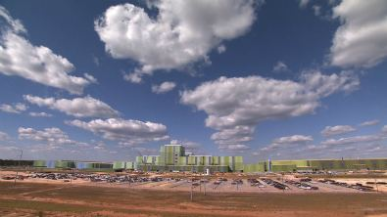The ThyssenKrupp Promise: Core Value of Social Responsibility Put to the Test in Alabama
Spring 2011

Some History
ThyssenKrupp launched this global expansion initiative almost 10 years ago. Many don't know that it was originally called Project Hercules and it was about diversifying their global footprint outside of Europe, leveraging the globe for competitive advantage, and deploying new technology and proven production processes that would revolutionize and forever change the steel industry in North America.
Halfway thru the 15-month site selection process that began in February 2006 and ended in May 2007, industry leaders and competitors got wind of the project and were befuddled that someone would fathom building a $3.7 billion, 2,700-person, 7 million-square-foot complex in a location where the infrastructure requirements would be astronomical and stretch the receptor state and localities beyond belief. Would the ROI be there for the company? Would the economic impact justify the $800 million incentive package? Would a German conglomerate be able to resource such a unique greenfield start-up in a new country with unfamiliar customs and requirements? How would all parties impacted be able to sustain the extraordinary performance needed to meet the stated goal of producing steel by the end of 2010?
The Promise Fulfilled
The celebration was warranted! Despite numerous board meetings back in Germany where echoes of "shuttle or downsize the project, preserve cash" gained traction due to the recession; mounting struggles with their equally sized massive project in Sepatiba, Brazil (the source of slabs to be processed in North America); and the extraordinary development issues back at the site north of Mobile (3,000+ acre greenfield site with huge infrastructure capacity building needs), ThyssenKrupp pulled it off!
Most Don't Know
It wasn't easy; ThyssenKrupp's stated core value of social responsibility was put to the test during the construction period. Many don't know that the company never laid off one employee during the recession, and every promise with respect to environmental compliance was met or exceeded at additional cost to the company (when not required). This was also one of the most successful permitting approval processes in the U.S. Army Corp of Engineers history, and the project included award-winning, aesthetically pleasing architecture and facility coloring, as well as berms to buffer the entire site from surrounding land uses.
Senior company executives and state and local officials said, "We must have good communications and solve problems together when they arise - we want to make this happen." Well it did happen, and the state of Alabama, ThyssenKrupp, and the thousands of people who made this mega project one of the most successful in U.S. history deserve to be congratulated.
Bob Hess is a leading advisor to corporations across the globe on complex location selection and expansion initiatives. He was in charge of the site selection advisory role for ThyssenKrupp.
Project Announcements
Southwire Expands Heflin, Alabama, Production Operations
11/17/2025
Fratco Establishes Fort Payne, Alabama, Manufacturing Operations
11/12/2025
SmartWiz Expands Birmingham, Alabama, Headquarters Operations
11/01/2025
Glaukos Plans Huntsville, Alabama, Manufacturing-Research Operations
10/18/2025
Southern Ionics Expands Tuscaloosa, Alabama, Manufacturing Operations
10/07/2025
Owens Corning Plans Prattville, Alabama, Shingle Manufacturing Operations
09/27/2025
Georgia-Pacific Expands Monroe County, Alabama, Cellulose Mill Operations
09/14/2025
Loftis Steel & Aluminum Expands Decatur, Alabama, Fabrication Operations
09/01/2025
Master Boat Builders Expands Coden, Alabama, Shipbuilding Operations
09/01/2025
Choice Fabricators Expands Rainbow City, Alabama, Production Operations
08/29/2025
Performance Drone Works Establishes Huntsville, Alabama, Manufacturing Operations
08/27/2025
L3Harris Technologies Expands Huntsville, Alabama, Manufacturing Operations
08/12/2025
Contour Fabrications and Mechanical Plans Heflin, Alabama, Manufacturing Operations
08/11/2025
MR6 Tech Services Plans Huguley, Alabama, Manufacturing Operations
07/29/2025
Most Read
-
The Workforce Bottleneck in America’s Manufacturing Revival
Q4 2025
-
Rethinking Local Governments Through Consolidation and Choice
Q3 2025
-
Lead with Facts, Land the Deal
Q3 2025
-
Investors Seek Shelter in Food-Focused Real Estate
Q3 2025
-
America’s Aerospace Reboot
Q3 2025
-
The Permit Puzzle and the Path to Groundbreaking
Q3 2025
-
Supply Chain Whiplash Reshapes CRE
Q3 2025


